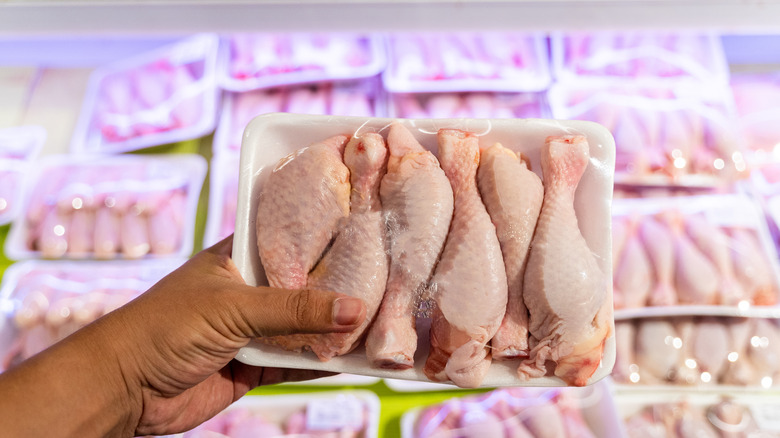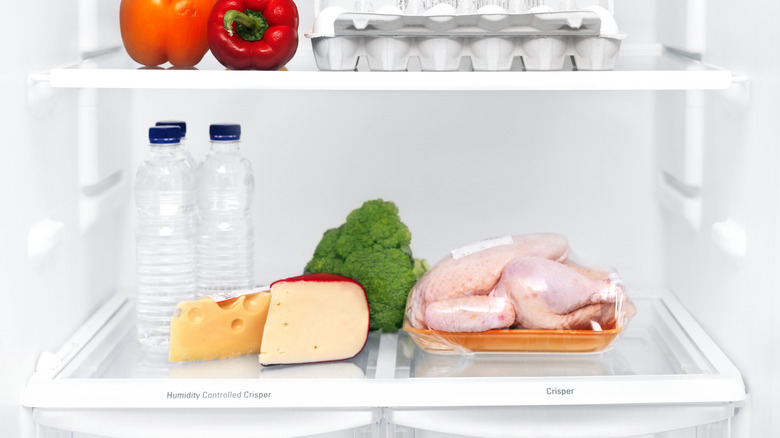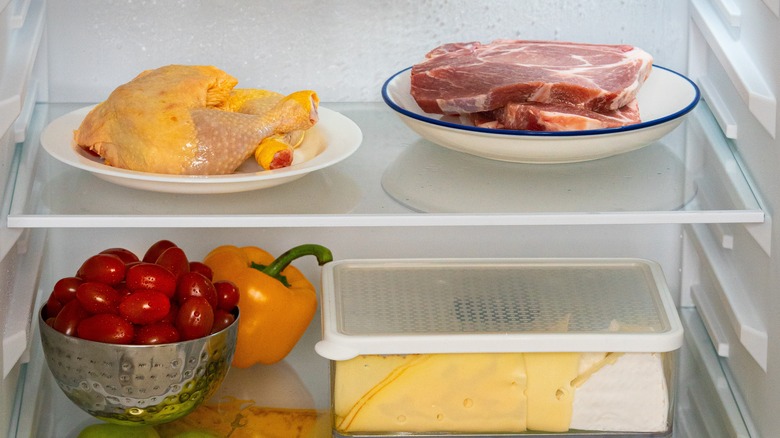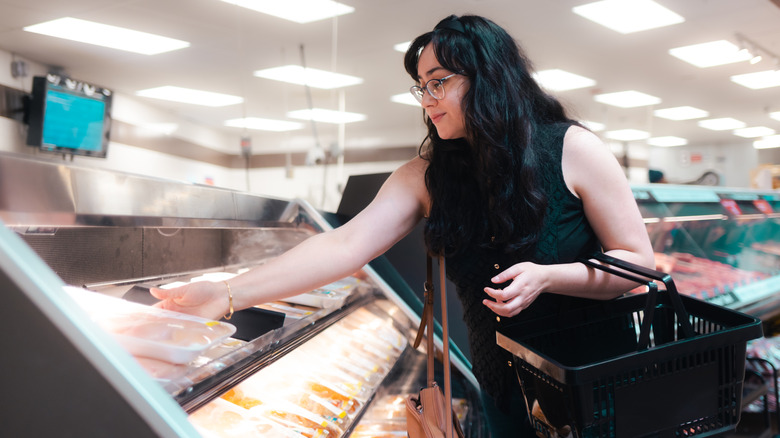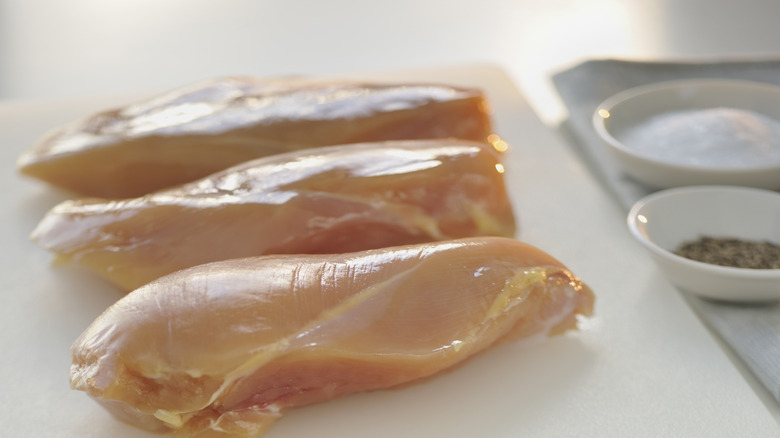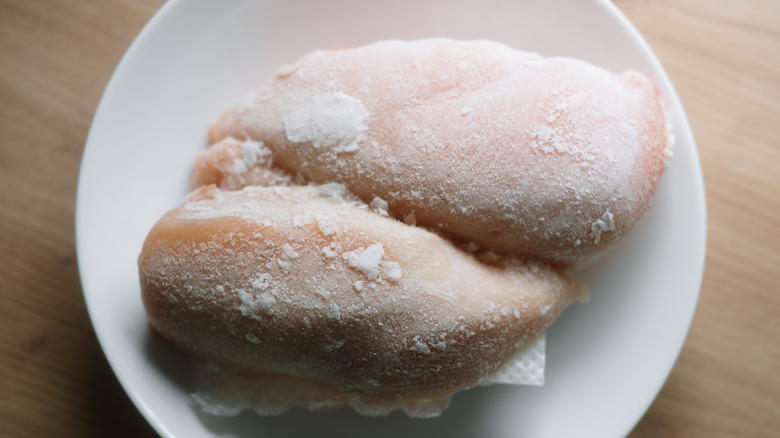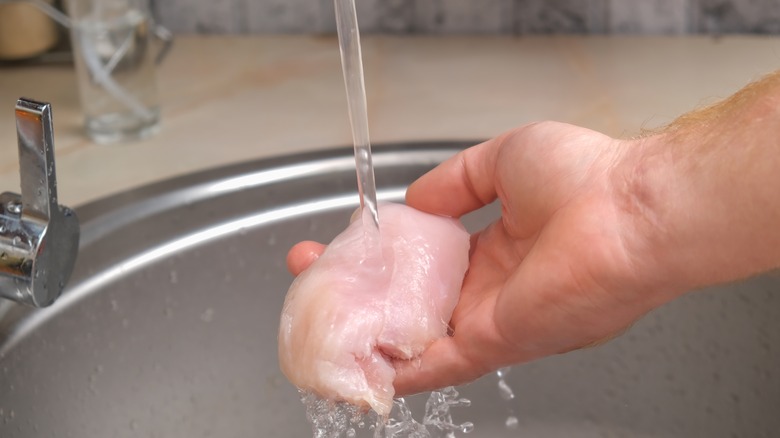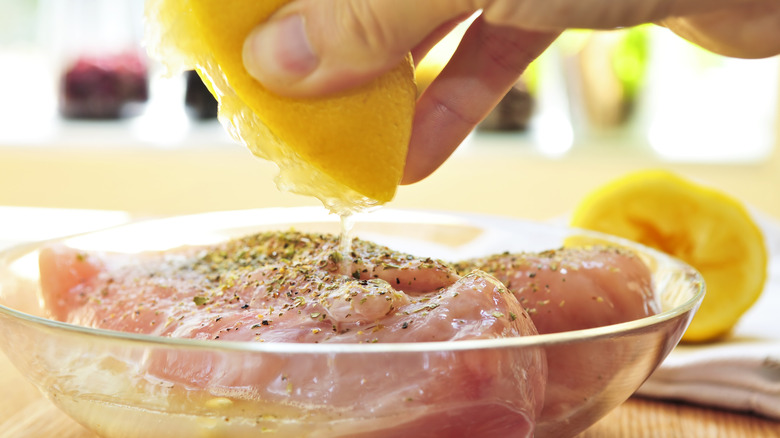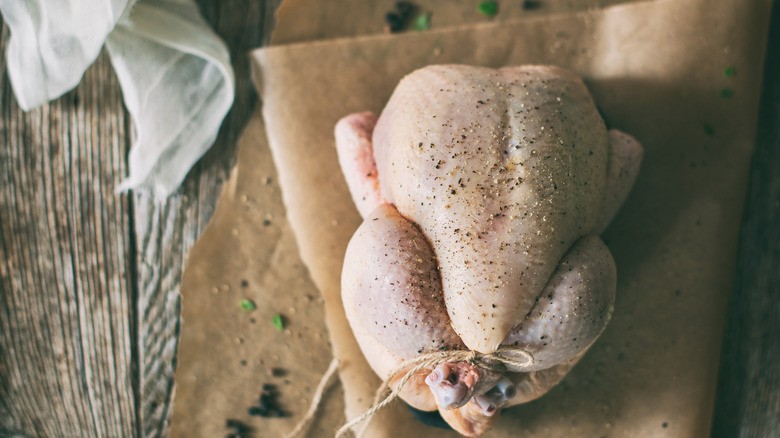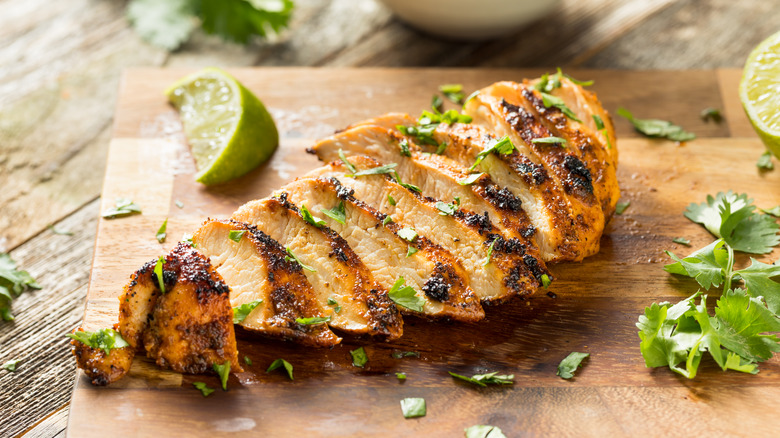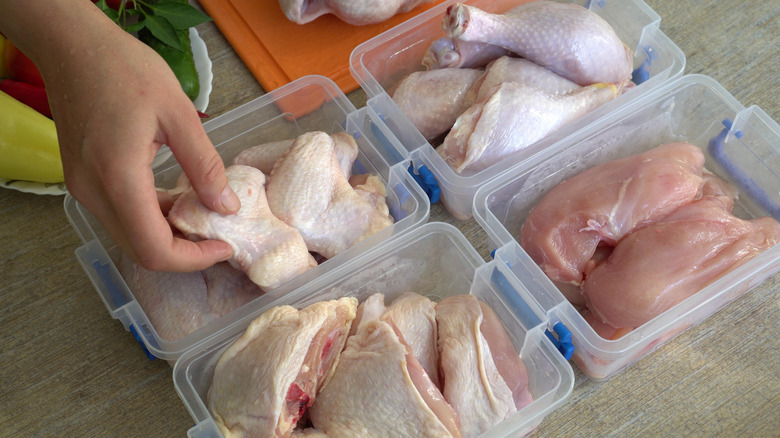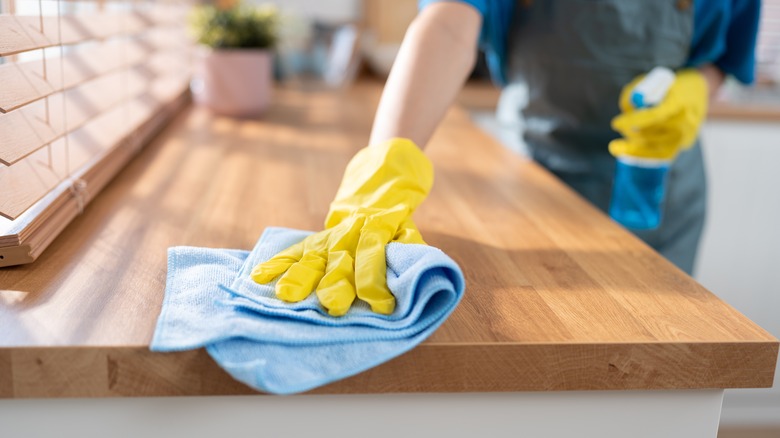11 Mistakes Health Experts Say You Should Avoid When Storing Raw Chicken
Chicken is a staple protein that many of us have in our meal routine. Whether it's chicken tenders, grilled chicken, or a comfort food like chicken pot pie on the menu, you can always count on poultry to be a crowd-pleaser. It's safe to say the dangers of raw chicken are well-known, but in case you're not convinced, safety officials say consuming raw chicken or its contaminants can cause foodborne illness or food poisoning. This is why cooking chicken until it has an internal temperature of 165 degrees Fahrenheit is key, along with also knowing the signs that your chicken has gone bad, whether it's by checking the texture or the smell.
You also can unintentionally expose yourself to foodborne illnesses in the preparation process. It all begins with how you store your chicken. There is a certain way to handle your raw chicken to mitigate the risk of illness. You may be making some big mistakes without even realizing it — like how you store your raw chicken in your grocery cart, your fridge, or your freezer at home. Food safety experts, microbiologists, and chefs weighed in on their raw chicken storage tips that can help keep you and your family safe from foodborne illnesses.
1. Mistake: Keeping your chicken near other foods in the fridge
It may be second nature to store your package of raw chicken wherever you have room in the fridge. However, experts say the proximity of the chicken in your fridge to other foods makes a big difference when it comes to food safety. "Raw chicken should always be stored separately from other foods in the fridge to prevent cross-contamination," said Jessica Gavin, a certified food scientist, certified culinary scientist, and recipe developer. "Raw chicken carries bacteria like Salmonella enteritidis, Staphylococcus aureus, Campylobacter jejuni, and Listeria monocytogenes that can quickly spread to other items, especially ready-to-eat foods like fruits, vegetables, or cooked dishes."
The less contact your chicken has with other foods in your fridge, the more you will see the risk of contamination decrease, according to Dr. Bryan Quoc Le, a food scientist, food industry consultant, and author of the book "150 Food Science Questions Answered." You can also go a step further and separate your chicken entirely from other food in your fridge.
"Ensure that raw chicken is stored in a separate drawer or container from other foods so that you can avoid cross-contamination with any raw juices," said Lisa Yakas, a trained microbiologist and senior account manager at the NSF.
2. Mistake: Placing the chicken on the top shelf
Another mistake to avoid is storing your raw chicken on the top shelf of your fridge. Experts say that all raw meats (not just chicken) shouldn't take the top shelf spot. "Meat should always be stored low in the refrigerator so that the juices from the raw chicken don't accidentally drip onto fruits, vegetables, or other foods that you won't eat before cooking," said Mitzi Baum, CEO of Stop Foodborne Illness.
Food scientist Jessica Gavin says instead of using the top shelf, you should keep your raw chicken on the lowest shelf or in a dedicated bin to prevent contamination. "Cross-contamination can occur easily if chicken juices come into contact with ready-to-eat items, leading to foodborne illnesses," she said. Even if you store your chicken in a lower part of the fridge, microbiologist Lisa Yakas recommends putting the raw chicken in an airtight container or sealed bag on a plate as a precaution so that any leaking juices are captured.
3. Mistake: Not handling your chicken properly at the store
A good practice is storing your raw chicken properly from the get-go — while still at the grocery store. While food scientist Bryan Quoc Le says your raw chicken should remain in its original packaging during storage, you may want to take extra precautions when your chicken is in your grocery cart with other food. The Centers for Disease Control and Prevention (CDC) recommends placing your package of raw chicken in a disposable bag before putting it into your cart. If you want to be extra careful, the same rules apply in your cart as do those when storing your chicken in the fridge. Get your chicken first so it rests at the bottom of your cart on the off chance that there is any leakage. That way, raw juices won't get onto the rest of the food in your cart.
The same recommendation applies when transporting chicken home. "Raw chicken juices can drip onto other foods, causing cross-contamination," said Lisa Yakas. You should keep your chicken in that disposable bag if it needs to be put in a grocery bag with other food. Also, try to keep your raw chicken bagged with other raw meat, as the plastic packaging doesn't guarantee no contamination will happen, according to the Institute of Food Technologists. Another reason to keep your chicken with other meats is because they have similar temperatures. Frozen foods, refrigerated foods, and shelf-stable foods should be in their own bags.
4. Mistake: Storing your chicken at unsafe temperatures
Experts say another big mistake to avoid is storing your chicken at an unsafe temperature. This means from the moment you pick up your chicken from the cooler at your grocery store, the clock starts ticking for how long it can be out at room temperature. If you have a long commute home, our experts have suggestions on how you can keep your chicken cool. "When purchasing raw chicken, keeping it in a cooler bag with ice or a cold pack can help to keep it at a cool temperature after you leave the store," trained microbiologist and senior account manager Lisa Yakas said. "Try to avoid making stops between the store and home, especially during warmer seasons."
Once you are home, you want to get your chicken immediately in the fridge — and be sure your fridge is cold enough. "It's also important to store raw chicken in the fridge under 40 degrees Fahrenheit to prevent harmful bacteria from breeding," said Mitzi Baum of Stop Foodborne Illness. Another consideration for proper temperature storage is the location in your fridge. "The door is typically the warmest place in the fridge, so avoid storing any meat on the door," she said.
You also want to regularly monitor the temperature of your refrigerator. Yakas suggested using a refrigerator monitor certified by the NSF to ensure your fridge's temperature stays cool enough to keep your food from spoiling.
5. Mistake: Trying to thaw your chicken incorrectly
Odds are that many of us have likely taken out frozen food and put it on the counter to thaw at room temperature for the day. However, thawing frozen chicken on the counter is a mistake. It can be dangerous as you cannot control the temperature of the raw chicken in this environment. "When thawing frozen raw chicken, make sure the internal temperature never gets into the 'danger zone' between 40 degrees Fahrenheit (4 degrees Celsius) and 140 degrees Fahrenheit (60 degrees Celsius), which can allow bacteria to multiply rapidly and cause foodborne illness," Lisa Yakas said.
To keep your chicken at that safe temperature, store your chicken in the fridge to thaw slowly overnight. It requires a little more forethought but can make all the difference in keeping that bacteria growth at bay. If you are in a pinch, you can defrost your chicken in the microwave safely. But you will want to plan on cooking it immediately afterward, as your chicken may partially cook using the defrost function and get to unsafe temperatures. You also don't want to try to speed up the thawing process by using hot water. On the other hand, thawing in cold water can be a safe tactic as long as you have a leakproof package or plastic bag and the ability to change the water every 30 minutes.
6. Mistake: Washing your raw chicken before cooking
To wash or not to wash? This is a big debate among novice and experienced chefs, but our experts have all come to the same consensus. "Chicken should not be rinsed before storing," Bryan Quoc Le said. "Washing chicken increases the probability of contaminating the surrounding kitchen area with Salmonella." In fact, washing your chicken could prove to be dangerous. According to a U.S. Department of Agriculture (USDA) study, more than 1 in 7 people still had bacteria in their sink after washing chicken — even though they cleaned their sink afterward.
"While your mom and grandma might have done it, washing chicken can spread harmful Salmonella and Campylobacter bacteria to other parts of your kitchen and foods," Mitzi Baum of Stop Foodborne Illness said. "Always wash your hands with soap and water after handling raw chicken and other raw meats and before touching anything else. This will help prevent cross-contamination." You can also prevent cross-contamination by keeping the chicken in its original packaging or using a leakproof container, according to Jessica Gavin.
If you do decide to move your chicken into a different container, Lisa Yakas recommends patting the chicken dry with a paper towel to remove the excess moisture, then throwing the paper towel away immediately. Afterward, place the chicken in airtight container or in a freezer bag with all the excess air removed.
7. Mistake: Marinating your chicken on the counter
Nothing beats a good marinade on your chicken to make it flavorful and juicy. But it's a big mistake to let your raw chicken sit on the counter while marinating — even if it's while you quickly prepare the rest of the meal. "If you're marinating, do it in the fridge, not the counter, to prevent bacterial growth," said Jessica Gavin. In fact, the USDA suggests chicken should be marinated for no more than 24 hours.
Instead of doing a countertop marinade, pour your marinade into a container with a tight lid or a zip-top bag and toss your chicken in. You can shake and flip your chicken a few times to evenly coat the meat before immediately putting the container or bag in the fridge. Putting it right back into a cooler environment means your chicken won't reach an unsafe temperature. Also, once your chicken is ready to cook, be sure to throw that marinade and bag away, as they are not reusable since they have been in contact with raw chicken. However, you can use the marinade for a quick last brushing on your meat before the chicken is cooked. If you used a container for the marinade process, be sure to wash it thoroughly before using it again.
8. Mistake: Not using your thawed raw chicken quickly enough
Time is an important factor to consider when deciding whether to keep your chicken in the fridge or freezer. Experts say that you must use your raw chicken within the first two days after thawing. "You can safely keep raw chicken in the fridge for up to two days before cooking. After that, the bacterial growth risk increases, even if stored at the right temperature," food scientist Jessica Gavin said. "If you're not planning to cook it within that time, it's best to freeze it. When you're ready to use it, thaw it in the fridge. Proper storage is key to keeping your meals safe and delicious."
When you start the cooking process, you want your chicken to be cooked completely through, and that means ensuring you reach the best temperature for perfectly cooked chicken. "Cooked chicken should have a minimum internal temperature of 165 degrees Fahrenheit (73.9 degrees Celsius) at the thickest part. This can be checked with an NSF-certified food thermometer," said Lisa Yakas, adding that you want to allocate more time when cooking your chicken from its frozen state. "Note that when cooking frozen, the cook time takes approximately 50% longer than the recommended time for fully thawed or fresh poultry," Yakas said.
9. Mistake: Leaving your raw chicken out of the fridge
This has been mentioned a few times already, but it is important enough to discuss further. As expert Jessica Gavin said, "When it comes to raw chicken, safety is paramount." It's not realistic to have your chicken out at room temperature for only a few minutes, but there is a certain time restriction to follow for food safety reasons. "At room temperature, raw chicken can only be left out for a maximum of two hours," expert Mitzi Baum said. "Any longer than that and the chicken will become a breeding ground for bacteria that cannot be killed through cooking the chicken and [it] is no longer safe to eat."
The reasoning behind that specific timeframe is to prevent your chicken from reaching that "danger zone" between 40 degrees and 140 degrees Fahrenheit. "Bacteria can double in as little as 20 minutes in this temperature range," Gavin said. "That's why avoiding leaving raw chicken out at room temperature for more than two hours is critical. If the ambient temperature is above 90 degrees Fahrenheit, that window shrinks to just one hour."
The same rule applies to cooked chicken, too. According to the CDC, you should refrigerate or freeze leftover chicken within two hours of the time it has been cooked or brought out of a cooler. That means you probably want to toss the leftover rotisserie chicken from your summer day picnic that's been sitting out for hours.
10. Mistake: Not freezing raw chicken properly
If you are panicking about using your chicken within two days, the freezer can be a lifesaver. "From a food safety perspective, all that matters is freezing the chicken before it's been in the refrigerator for too long," expert Mitzi Baum said. How you freeze your chicken can affect its quality. Expert Bryan Quoc Le explains the process: "Wrap the chicken tightly in plastic wrapping, then cover in aluminum foil or place in a sealable plastic bag. This will help reduce freezer burn as there is less contact between the chicken and the surrounding air in the freezer."
You can freeze your chicken in its original packaging, but you may find it not ideal for long-term storage. "You can keep it in its original packaging for short-term freezing (a month or less). However, since the plastic wrap is somewhat permeable to air, the chicken's quality can decrease over time due to freezer burn," expert Jessica Gavin said. "For longer storage, it's better to overwrap the original packaging with foil to add an extra layer of protection."
Once your raw chicken is frozen, your window of opportunity gets much longer. "In the freezer, fresh poultry pieces can be stored for up to nine months, and whole poultry can be stored 12 months before cooking," Lisa Yakas said. Label your freezer bag or container with the date to track the chicken's freshness. Freezing smaller portions of chicken may also make them easier to defrost.
11. Mistake: Not sanitizing your kitchen after working with raw chicken
Foodborne illness can also be contracted during the storage process, and this is especially true when handling raw chicken. According to the NSF's Germiest Places in the Home Study, E. coli is most often found in the kitchen on dish sponges, rags, kitchen sinks, countertops, and cutting boards. This is because warm and moist environments are the best breeding grounds for germs, according to Lisa Yakas. "Cleaning and disinfecting during the food preparation process can significantly reduce the risk of foodborne illness. Make sure you properly wash your hands and that you clean and disinfect the kitchen before and after cooking," Yakas said.
Jessica Gavin echoes the importance of hand-washing and sanitizing surfaces that come into contact with the raw chicken. The same cleanliness should go for your cooking utensils while you prepare your meal. You will want to use a separate cutting board for chicken and other food items (or thoroughly wash the same cutting board before another use) to prevent cross-contamination during the preparation process. A clean kitchen means you and your guests can safely enjoy a home-cooked meal!
